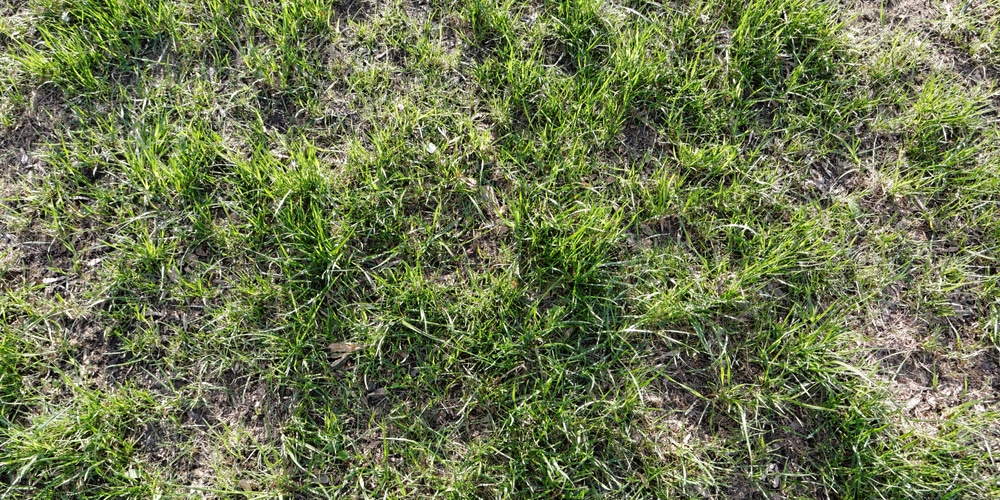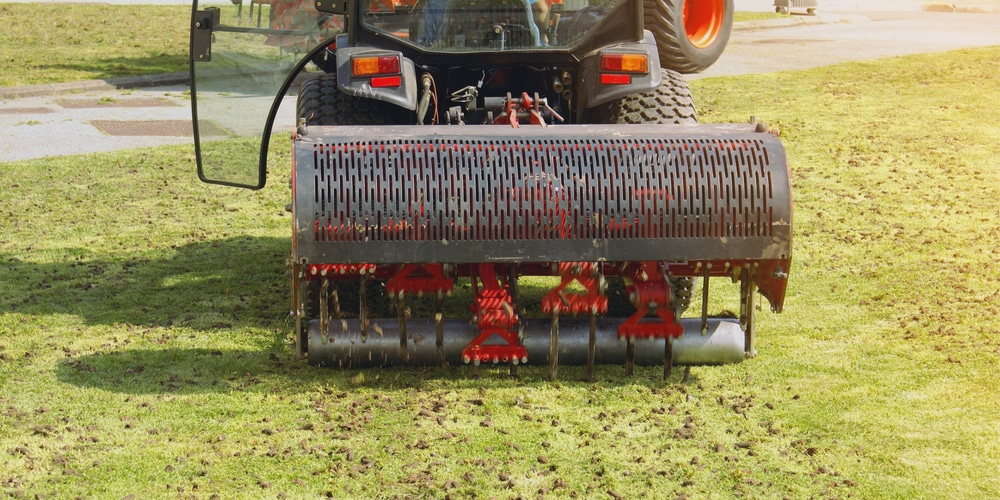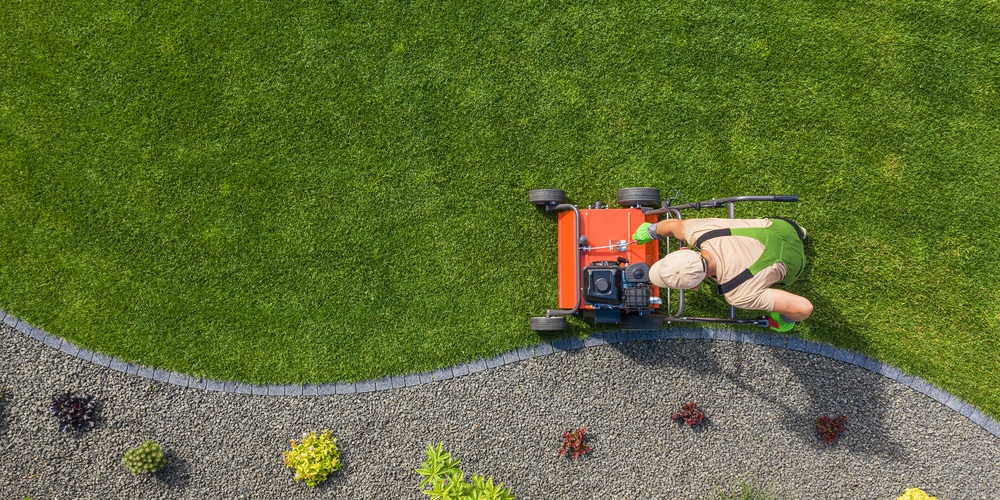Assessment of Your Lawn’s Condition
Before you can bring your lawn back to vibrant health, it’s critical to understand what you’re dealing with.
A precise assessment helps target your revival efforts effectively.
Identifying Patchy Areas
First, you need to walk the entirety of your lawn and note any areas where grass is thinning or completely absent.
Look for variations in color, texture, and density.
You may want to create a sketch or use a lawn mapping app to keep track of these patchy zones.
Quantify the damage: are patches localized, or do they cover more than half of your lawn?
Determining the Cause of Patches
Identifying the cause of your lawn’s patchiness is vital to remedy the issue.
Signs of poor health may include thin grass, discoloration, or bald areas.
There can be multiple culprits:
- Soil Compaction: Hard soil prevents roots from thriving. An easy test is to see if you can easily insert a screwdriver into the soil. Resistance indicates compaction.
- Poor Nutrition: A soil test can reveal nutrient deficiencies. Illinois lawns often require balanced fertilization to rectify undernourishment.
- Pests or Disease: Look for patterns like circular patches that indicate fungal disease or irregular areas where pests might be feeding.
- Water Issues: Overwatering can lead to fungal growth, while underwatering may dry out patches.
Observe your lawn after rainfall or irrigation for pooling or dry spots.
- Light Conditions: If parts of your lawn are under heavy shade, grass might struggle or fail to grow. Evaluate sunlight exposure across your lawn.
Preparation for Lawn Revival
Before you dive into the hands-on work, it’s crucial to ensure that your lawn has a strong foundation.
Proper preparation sets the stage for a lush, vibrant lawn that can withstand the unpredictable Illinois climate.
Soil Testing and Amendment
Soil Testing: The health of your grass begins beneath the surface, so you should start by testing your soil.
This will identify pH levels and nutrient deficiencies that can hinder grass growth.
In Illinois, ideal pH values for lawn soil typically range from 6.0 to 7.0.
Use a home test kit or consult with a local extension office for a comprehensive analysis.
Soil Amendment: Based on your soil test results, amend soil deficiencies with the appropriate materials. For instance:
- For acidic soil (pH below 6.0), add pulverized lime to raise the pH.
- To increase nutrient levels, work in a layer of compost, which can provide a rich source of organic matter.
Aeration: If your test shows compaction, aerate the soil to improve oxygen circulation, drainage, and nutrient absorption.
Rent a core aerator, which removes plugs of soil, for the best results.
Choosing the Appropriate Grass Seed
Match the Seed to the Climate: In Illinois, with its cold winters and hot summers, you need a grass type that’s resilient.
Cool-season grasses like Kentucky Bluegrass, Fine Fescue, or Perennial Ryegrass are popular and can handle temperature fluctuations.
Shady or Sunny: Be aware of how much sunlight your lawn receives. Some grass species need full sun, while others are shade-tolerant.
- Full sun areas: At least 6 hours of direct sunlight, ideal for most cool-season grasses.
- Partially shaded: 4-6 hours of sun. Fine Fescues or shade-tolerant blends are better suited.
Lawn Repair Techniques
To revitalize your Illinois lawn, implementing specific repair techniques during the appropriate season is crucial.
The following methods are tailored to address common issues such as soil compaction, dehydration, and thatch accumulation that undermine the health of your lawn.
Aeration and Overseeding
Aeration involves perforating the soil with small holes to allow air, water, and nutrients to penetrate the roots of the grass.
- Timing: Best performed in the fall.
- Tools Needed: Aeration can be done using a spike aerator or a plug aerator.
Overseeding is the process of planting grass seed directly into existing turf, without tearing up the turf or the soil.
- Best Practice: Overseed immediately after aeration when the seeds can make direct contact with the soil.
- Grass Types: Use a grass seed mix suitable for Illinois climates, such as Kentucky Bluegrass or Tall Fescue.
Proper Watering Methods
Frequency and Amount:
- General Guideline: Lawns typically need about 1 to 1.5 inches of water per week.
- Deep Watering: Encourages roots to grow deeper, 1-2 times a week is sufficient.
Techniques:
- Early Morning Watering: Less water is lost to evaporation.
- Use of Rain Sensors: To avoid overwatering during natural rainfall.
Thatch Removal
Thatch is a layer of dead and living grass shoots, stems, and roots that shows up between the soil and the living grass blades.
- Healthy Thatch Layer: Should be less than 1/2 inch thick.
Removal Techniques:
- Dethatching Rake: For small areas or minor thatch problems.
- Power Dethatcher: For larger lawns or severe thatch issues.
Lawn Maintenance Practices
A lush, green lawn is the centerpiece of your home’s outdoor space, and maintaining it requires a strategic approach.
Dive into these targeted practices to ensure your lawn stays healthy and recovers well from any patchiness.
Regular Mowing
To maintain a uniform lawn, mow your grass at the ideal height, which typically ranges between 2.5 to 3 inches for most cool-season grasses in Illinois.
Mowing too short can stress the grass and lead to weed invasion, while letting it grow too long can encourage pests and diseases.
Use a sharp mower blade to ensure a clean cut, and follow the one-third rule: never remove more than one-third of the grass blade length at a time.
Fertilization Schedule
Your lawn’s nutrition is crucial.
Fertilize with a balanced blend of nutrients tailored to your specific type of grass.
In Illinois, it’s recommended to fertilize cool-season grasses mainly in the fall and spring. A sample schedule might look like this:
- Early Spring: Apply a light feeding of a balanced, slow-release nitrogen fertilizer.
- Late Spring: Use a fertilizer with pre-emergent herbicide.
- Fall: Apply a high-nitrogen fertilizer to help recover from summer stress and prepare for winter.
Weed Control Measures
Effective weed control combines preventive and targeted approaches.
Pre-emergent herbicides in early spring prevent weed seeds from germinating.
If weeds have already appeared, apply post-emergent herbicides directly to them.
Always read labels carefully and choose products suitable for your lawn type, ensuring they target the weeds prevalent in your Illinois lawn without harming the grass.
Seasonal Lawn Care Tips
Keeping your Illinois lawn lush and healthy year-round requires a proactive approach.
Each season brings unique challenges and opportunities for lawn care, so understanding what your grass needs as the weather changes is crucial.
Spring Lawn Prep
With the thawing of winter, it’s time to energize your lawn for the upcoming growing season.
- Aerate: If your lawn is compacted, spring is a great time for aeration. This process allows oxygen, water, and nutrients to better reach the roots of your grass.
- Fertilize: Apply a balanced fertilizer to promote strong root growth. Look for one that’s rich in nitrogen, which is particularly important for spring growth in Illinois.
Summer Upkeep
Summer heat can be taxing on your Illinois lawn. Your focus should be on maintenance and stress prevention.
- Watering: Offer your lawn about 1 to 1.5 inches of water per week, either from rainfall or irrigation.
- Mowing: Keep your lawn at about 3 inches in height to protect it from heat and allow roots to stay moist.
Fall Renovation
As the heat subsides, fall is a chance to repair any damage and prepare your lawn for the cold months.
- Overseed: If you have thin or bare patches, overseed your lawn with a cool-season grass blend suited for Illinois.
- Fertilize Again: Use a winterizing fertilizer late in the fall to help roots store nutrients for the dormant period.
By following these specific seasonal tips, you’ll help ensure that your lawn remains a vibrant and enjoyable space throughout the year.
Frequently Asked Questions
Embarking on lawn repair can be imposing, but armed with the right knowledge, you can cultivate a lush, green yard.
Here are some pointed answers to common quandaries regarding the revival and maintenance of your Illinois lawn.
What are effective methods for repairing large bare spots in a lawn?
To repair large bare spots, it’s essential to first remove any dead grass and loosen the soil.
Adding topsoil or compost can improve soil health, followed by evenly spreading grass seed or laying down sod strips, adjusting them to the level of the existing lawn.
When is the ideal time to undertake lawn repair in Illinois?
In Illinois, the best time for lawn repair is during the fall or early spring.
These seasons offer moderate temperatures and ample rainfall, which are conducive for seed germination and root development.
Which grass patch repair products are recommended for optimal results?
Opt for grass patch repair products that match your existing lawn and the climate of Illinois.
Products that contain a mixture of seed, mulch, and fertilizer tend to give excellent results when used according to the package directions.
What steps should one follow to quickly rejuvenate dead grass?
Aerating the soil and removing thatch can improve soil conditions rapidly.
Afterward, sow new grass seed, making sure to water the area daily to establish new growth. Consistent watering is key to rejuvenation.
Can regular watering revive grass that has died?
If grass has completely died, watering alone will not revive it.
However, proper hydration can prevent healthy grass from dying and assist new growth in establishing itself after seeding or sodding bare spots.
What are the common causes of bare spots in lawns?
Common causes include heavy foot traffic, pet urination, drought, shade, and lawn diseases or pests.
Identifying and addressing the underlying issue is crucial before attempting to repair the bare spots.
Last update on 2025-06-06 / Affiliate links / Images from Amazon Product Advertising API





